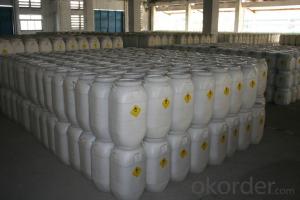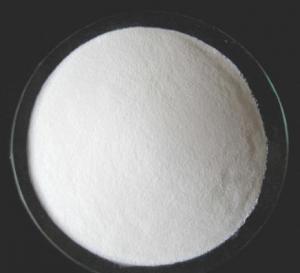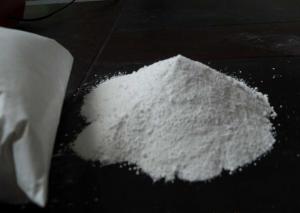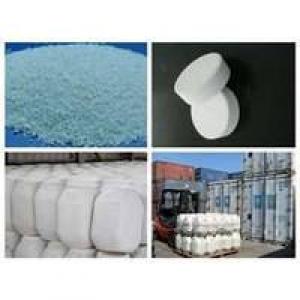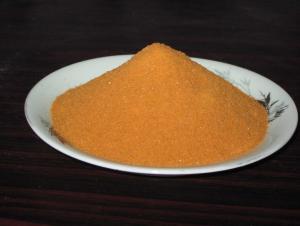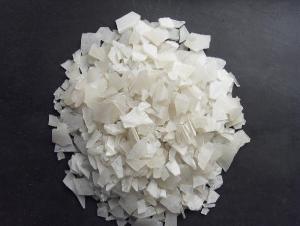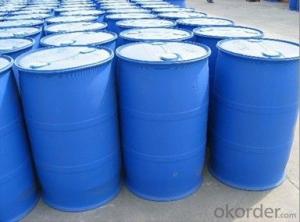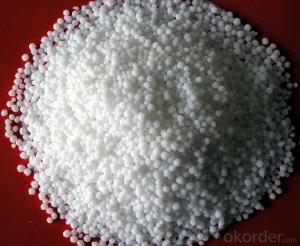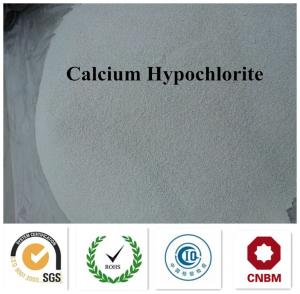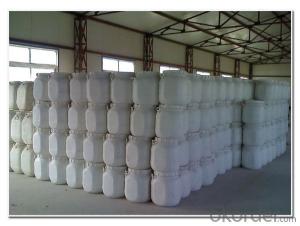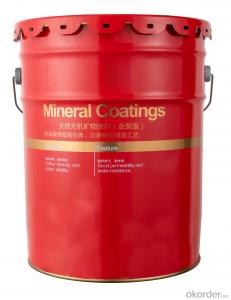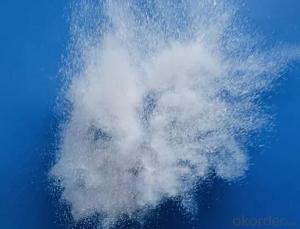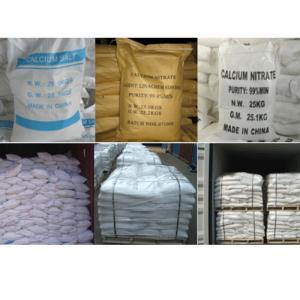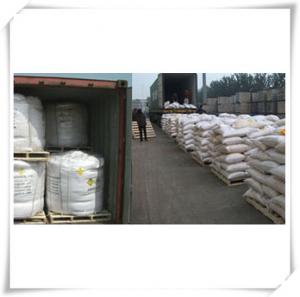Water Treatment Calcium Hypochlorite Granular Powder
- Loading Port:
- Tianjin
- Payment Terms:
- TT OR LC
- Min Order Qty:
- 25 m.t.
- Supply Capability:
- 2000 m.t./month
OKorder Service Pledge
OKorder Financial Service
You Might Also Like
Calcium Hypochlorite
Introduction:
CNBM GROUP is the biggest water Treatment Factory in China. Our Product include: Calcium Hypochlorite, TCCA, SDIC, PAC, Sodium Sulphite, Sodium Thiosulfate etc.
CNBM One year can produce 18,000MT Calcium Hypochlorite with two model, one is 65% and one is 70%. More important we have 3 advantages, Firstly: High effective chlorine content Secondly: Good stability. Can be stored a long time at normal temperature with little chlorine loss; Third:Good solubility, less water-insoluble matters.
Technical Specifications:
Calcium Hypochlorite 65%
Index Name | Top Grade | First Grade |
Chlorine Content ≥ | 65% | 60% |
Moisture ≤ | 3% | 3% |
Yearly Loss of Active Chlorine | 8% | 8% |
Calcium Chloride | 9% | 10% |
Color | White or Light-grey | ----- |
Shape | Power & Granular |
|
Calcium Hypochlorite 70%
Index Name | Top Grade | First Grade | Quality Product |
Chlorine Content ≥ | 70% | 67% | 65% |
Granularity(14-50 mesh)% ≥ | 90 | 87 | 87 |
Moisture % | 5.5~10 |
|
|
Tablets Forms
Weight | 200 gram | 150gram | 100gram | 50gram | 30gram | 20gram | 15gram | 10gram |
Diameter(mm) | 76 | 70 | 50 | 42 | 30 | 30 | 30 | 30 |
Height(mm) | 25 | 21 | 26 | 27 | 22 | 16 | 12 | 8 |
Applications:
1. For bleaching purpose of wood pulp, silk, cloth and fibre.
2. Disinfection and water-treatment.
3. Disinfectant for chemical poisonous and radioactive substance.
Formula Experiment Design: (Base on 1MT Water)
Constitue Dosage
Calcium Hypochlorite 65% 100kg
Disinfection Liquid 1% Calcium Hypochlorite 65% 1.7g
Shipping Containers:
45—50kg Plastic or Steel Drums with Inner Plastic Bag.
Cautions
1. Should be stored in cool and dry warehouse away from heating sources and avoid direct sunlight.
2. In transportation, contact with such should be avoided as sunlight, heating,moisture, organics, oil and acids.
Other Information please check the MSDS.

| alcium Hypochlorite, Sodium Process | Calcium Hypochlorite, Calcium Process |
| Trichloroisocyanuric Acid (TCCA) | Sodium Dichloroisocyanurate (SDIC) |
| Sodium Dichloroisocyanurate Dihydrate | Cyanuric Acid (CYA) |
| Sodium Hypochlorite | Sodium Chlorite |
| BCDMH | Aluminum Sulphate |
| Soda Ash Light / Dense | Sodium Bisulphate (NaHSO4) |
| Caustic Soda | Copper Sulphate (CuSO4) |
| Poly Aluminium Chloride (PAC) | Calcium Chloide (CaCl2) |
| Sodium Metabisulfite | Sodium Hydrosulfite |
| Poly Acrylic Acid (PAA) | Sodium Polyacrylate (PAAS) |
| Sodium Nitrate | Calcium Nitrate |
| 1-Hydroxyethylidene-1, 1-Diphosphonic Acid (HEDP) | Amino Trimethylene Phosphonic Acid (ATMP) |
| Copolymer of Maleic and Acylic Acid (MA-AA) | Benzalkonium chloride |
| Sodium Lauryl Ether Sulphate (SLES 70%) | Dodecyl Alkyl Benzene Sulfonic Acid (LABSA 96%) |
- Q:The addition of inorganic salt viscosity of micelles increased first and then increased again and then reduced, there is no possibility ah? Yes, then what is the reason for the increase ah?
- possible. The inorganic salt is dissolved in water to form positive and negative ions, and the ions of the micelles are extruded to make the solubility smaller and form an increase in the viscosity. With the increase in the amount of inorganic salt, it does not have the ability to dissolve in water, there is no micelles and the molecular state exists in the water, the liquid becomes thin ...
- Q:Is the inorganic salt the same as the saline?
- Inorganic salts are inorganic compounds in the tears, originally called minerals. A large number of elements are calcium Ca, phosphorus P, potassium Ka, sulfur S, sodium Na, chlorine Cl, magnesium Mg, trace elements iron, zinc, selenium, molybdenum, fluorine , Chromium, cobalt, iodine and the like.
- Q:salt is organic or inorganic?
- Salts are ions such as NaCl. Organic salts contain carbon and inorganic salts contain no carbon. So NaCl would be an inorganic salt.
- Q:An inorganic salt is dissolved in water and yields a solution that has a color. Make a statement about the type of element the substance contains that casuses the color.Thanks!
- Many inorganic salts form colored solutions . pper ( II) sulfate ( Blue ) nickel (II) acetate = green, mangaanse ( II) chloride = pink, iron(III) chloride = yellow, potassium dichromate, orange and so many more Can you be more specific ?
- Q:Inorganic salt function
- Ca2 + is the animal bone and teeth (containing CaCO3) composition, and blood coagulation and muscle contraction has a regulatory role, if the content is too low, the animal will appear muscle twitch. K + is a variety of enzyme activator, for the plant starch and protein synthesis and animal nerve impulse conduction and muscle contraction also plays an important role. Fe is a component of hemoglobin and cytochrome, and iron-containing enzymes are indispensable when chlorophyll is formed in plants. Another example is Na + for animal heart beat, nerve excitement is indispensable.
- Q:I'm said that with the increase of temperature the inorganic salts will decrease. Will that be correct?
- Usually solubility will increase with increasing temperature but there are a significant number of exceptions which show the opposite.
- Q:What is the difference between inorganic and inorganic salts?
- Inorganic salts are salts of inorganic substances, including salts produced by strong acids, salts produced by inorganic weak acids, and salts of small amounts of organic acids.
- Q:Are there any differences between minerals and inorganic salts?
- There are differences, some minerals exist in organic matter, and some minerals are inorganic salts. Inorganic salts are inorganic.
- Q:The stronger the transpiration is, the faster the absorption rate of inorganic salts and water is
- wrong. Can only promote the transport up! Can not promote absorption.
- Q:Cells in the water, inorganic salts, protein, lipid, carbohydrate and nucleic acid six words how wrong this sentence
- Plus a "so" on the right, because there are many other compounds in the cell
1. Manufacturer Overview |
|
|---|---|
| Location | |
| Year Established | |
| Annual Output Value | |
| Main Markets | |
| Company Certifications | |
2. Manufacturer Certificates |
|
|---|---|
| a) Certification Name | |
| Range | |
| Reference | |
| Validity Period | |
3. Manufacturer Capability |
|
|---|---|
| a)Trade Capacity | |
| Nearest Port | |
| Export Percentage | |
| No.of Employees in Trade Department | |
| Language Spoken: | |
| b)Factory Information | |
| Factory Size: | |
| No. of Production Lines | |
| Contract Manufacturing | |
| Product Price Range | |
Send your message to us
Water Treatment Calcium Hypochlorite Granular Powder
- Loading Port:
- Tianjin
- Payment Terms:
- TT OR LC
- Min Order Qty:
- 25 m.t.
- Supply Capability:
- 2000 m.t./month
OKorder Service Pledge
OKorder Financial Service
Similar products
New products
Hot products
Related keywords
